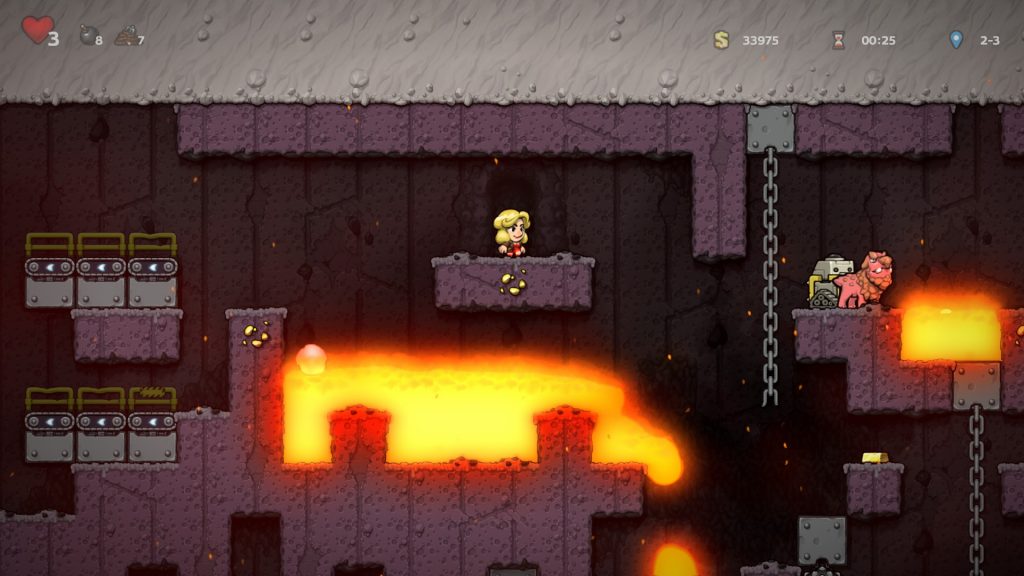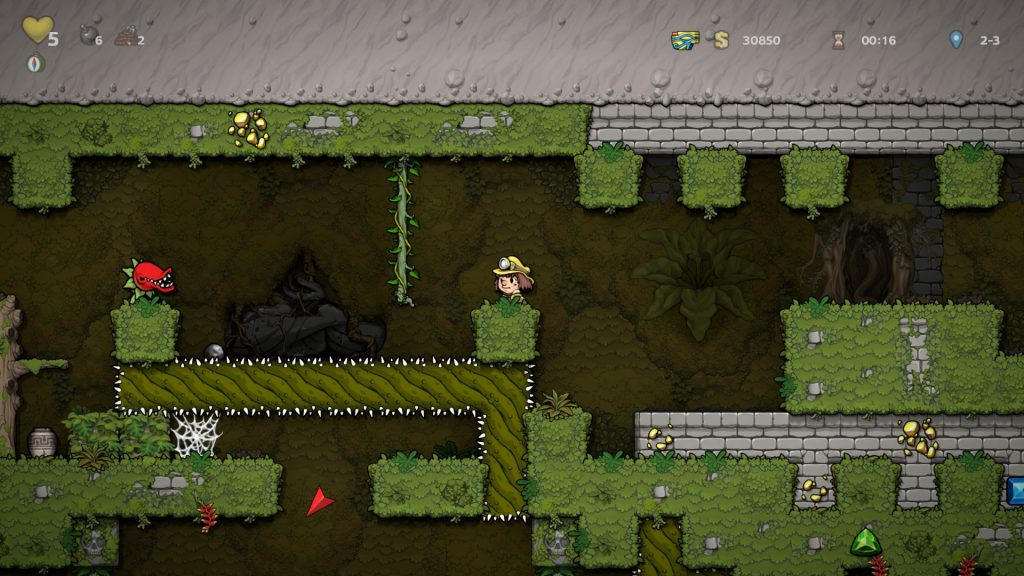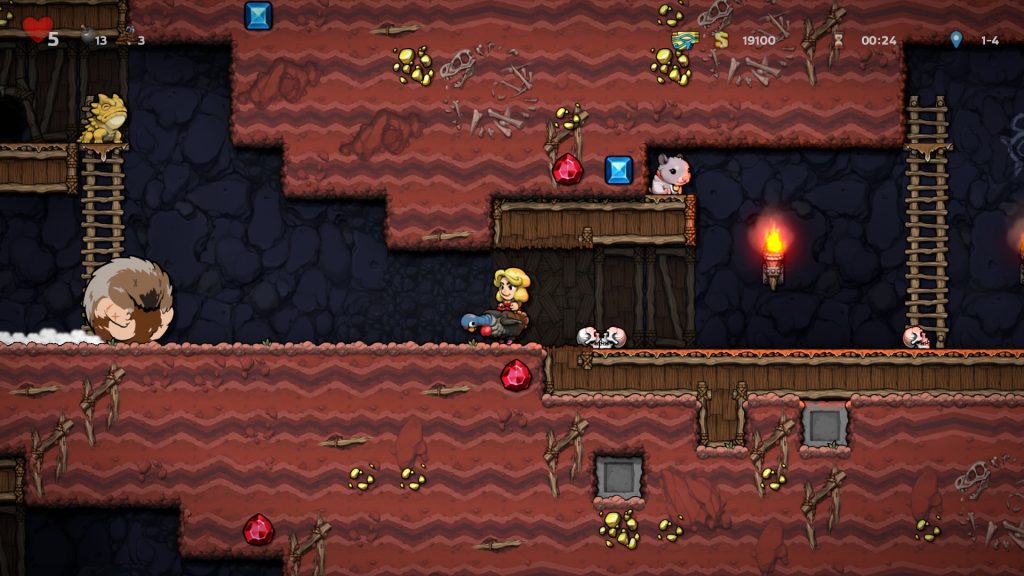Spelunky is arguably one of the most recognizable action roguelikes and the game that began this trend of introducing roguelike design to new genres. The original’s use of procedural generation and combining that with challenging platforming remains unique to this day. After eight years following the re-release, Spelunky 2 has some very big shoes to fill that I feel it doesn’t quite get there.
Next Generation Spelunker
Our story finds the daughter of the hero of the first game in search of her parents after they have been mysteriously guided to a new temple on the moon. The story once again is just a framework to send the player into deathtrap-filled environments in search of treasure. The basic structure of Spelunky remains the same — each biome is full of unique traps, enemies, and events to stand in your way.
For those who missed the original, Spelunky’s claim to fame was with its use of procedural generation when it came to designing the biomes. Each stage will test your platforming and item management skills to make it to the exit somewhere along the bottom layer of each floor. For Spelunky 2, the developers have increased the difficulty all around. New enemies can be nuisances at least or the reason you died at worst. To give you a sense of the difficulty scale — lava, which was an instant kill in the first game and not introduced until the end of the game, is now on full display in the second biome.
The biggest change to the formula this time around is that the player can now choose different biomes to visit at specific crossroads. The procedural generation can generate tunnel sections that can provide shortcuts through levels. The one new feature that directly benefits the player is being able to find, charm, and ride mounts in many biomes. These mounts provide the player with a free double jump and can take a few hits before they die.
Spelunky 2, like the first game, is not the most complicated roguelike on the market, but the appeal remains in how the game can set up spectacular successes, or failures.
Welcome to Die
While I wouldn’t go as far to say that Spelunky or Spelunky 2 would be examples of emergent gameplay, or letting the player create their own interactions, the series has a very logical and organic feel to it. There are lots of ways to die in the game, just as there are ways to kill or get around enemies. A lava pit standing in your way could just as well be bombed out to rain lava on enemies below. Everything in the game has a behavior and action associated with it, and it’s up to the player to figure out the best way to exploit it.
Nothing in Spelunky 2 happens at random or chaotic. The whole M.O. of the game is a series of little incidents that blow up and escalate fast. A misplaced bomb throw could upset a shopkeeper who then charges you with a shotgun, knocks you into a pit where a spike totem then stabs you all within a span of 2 seconds.
There are fewer biome affecting events from what I’ve seen in Spelunky 2, but that has been made up by having more biomes compared to the original’s 5 (secret one included). Each biome is an obstacle course onto itself, and I hope is the foundation to see more added with supplemental content down the line. As with the original, there are biome-spanning secrets that astute players are already uncovering to find rare items and new biomes as we speak.
All and all, Spelunky 2 is more Spelunky, but is that enough in 2020 to wow fans and bring in newcomers?
Repeated Runs
As mentioned at the start, the original Spelunky paved the way for action roguelikes and the entire confusion surrounding the term roguelike. Spelunky 2 feels like the logical next step from the first, but it comes out in a far different market. In the last few years, we have seen amazing examples of action roguelike design — Dead Cells, Hades, and more that have moved things forward. Spelunky 2 is by no means a bad game, but it does feel a little dated by not having the first game luxury of the original.
Let’s get things straight: Spelunky 2 is a hard game. So much harder that I would honestly suggest newcomers play the first game before trying this one to have a fighting chance. If you’re hoping for any improvements or new game systems other than the ones mentioned, you will be disappointed in the sequel. For another example of the increased difficulty, the end boss of Spelunky is now the third biome fight and is even harder and more complex than before. As the author of an upcoming book on roguelike design, I know that playing games with procedural generation is all about luck with programmed algorithms, but that doesn’t stop me from saying that Spelunky 2 is “meaner” than the first one.
This is not a game about ramping up the difficulty, it is hard from moment one. I have friends who have been playing the game for hours and have barely made it to biome 3. The procedural generation seems to be set up to create harder sections than in the first game. There were many times where enemies would just swarm an already death trap-filled area, or the game’s infamous arrow traps set up in an area that you have no choice but to consume an item to avoid the damage. One of my “favorite” examples is setting up enemy spawns either directly inside or outside a tunnel where there is no way to see them and they get a free hit on the player.
Item usage is a big deal as in the first game, but it has been taken further here. The number and variety of hazards this time around almost always requires ropes or bombs to safely get by. There were several occasions where a path almost turned into a soft lock if I didn’t have a bomb or rope available.
Spiked
Spelunky 2 is a lot more demanding than the first, and your opinion of the game is going to depend on what you wanted out of a sequel or of action-roguelikes today. When I think about the other ones I’ve enjoyed in the past three years, they have done more to accommodate a larger playerbase while still providing the edge for expert players. Spelunky 2 doesn’t do that, and it feels more like Spelunky 1.5, or Spelunky “New Game +” than a full-on sequel. I cannot stress this enough, if you are new to the Spelunky series, do not immediately jump into Spelunky 2.
Despite the new biomes and features, I feel that Spelunky 2 still has an issue when it comes to variance in runs. The high skill floor required to play this game doesn’t leave much room for the game to surprise an expert player. There are already people who have beaten the game and are going for the bonus challenges. I feel that if I do make it that far, I won’t have the desire to keep playing it to find new things or just to enjoy the game in the same way as The Binding of Isaac or Hades kept me coming back.
Ultimately, I feel that Spelunky 2 is a case of a game that is trying too hard to cater to its extreme fans. All the changes and additions to the game except for mounts clearly make the game harder, but I don’t know if it makes it enjoyable. The first game was balanced that you could have a run with no useful items or poor shop selection, and still have a chance at beating the game. This time, there are far too many examples of the procgen requiring items instead of supplementing the player’s abilities. In the first game, the procgen would always allow for multiple paths and avoided purposely creating soft lock scenarios. This time, the game seems to welcome trapping the player unless they have items to break out. I feel that part of this issue is how the game handles its multiple paths.
As mentioned, there are already people who are going strictly for the secret endings and extra-hard biomes. Completing these tasks require not only doing a specific set of instructions in the game’s biomes, but having the bombs, ropes, and kapala, to have even the basic chance of surviving. The game seems to be balanced around those players as opposed to everyone else. The “fly by the seat of your pants” style of the first game has been replaced by “if I don’t get these items to spawn, I might as well just quit now.” This is further compounded by just how easy it is to die. When you are hit in Spelunky 2, you are dazed for at least 3 seconds, which is more than enough time for the myriad of enemies and threats to stun you into death.
Of course, expert players will chime in here and say “well, just don’t get hit, what’s the problem?” But that kind of design as we’ve discussed in previous design posts is not good — focusing on catering to one specific niche of your fanbase does not make a balanced game. And trust me when I say that things are “niche” for Spelunky 2, with less than 10% of the playerbase on Steam at the time of this post able to beat the game with any ending.
Spelunky as a design is one-of-a-kind, or now two-of-a-kind, and deserves praise for this kind of gameplay loop. However, in a market full of action roguelikes, roguelites, and other combinations, this one must be labeled as “for the hardcore fans only.”
(Note: The game has received several balance patches to try and curtail some of its difficulty, they have not fixed the issues mentioned in this post at the time of writing. There is the possibility that some of these problems will be fixed in the future, but I can’t analyze a game on possible additions)
If you enjoyed my post, consider joining the Game-Wisdom discord channel open to everyone.




